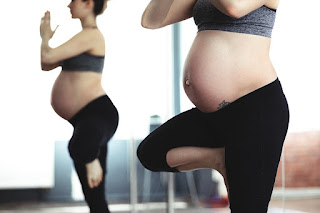Regular exercise during pregnancy can help you stay healthy, improve your posture, reduce constipation, prevent wear and tear on your joints (which become loosened during pregnancy), relieve anxiety, decrease some common discomforts such as fatigue and backaches. Studies has shown that physical activity such as exercising may prevent gestational diabetes (diabetes that develop during pregnancy) relieve stress and build more stamina needed for labor and delivery.
The American College for Obstetrics and Gynecology recommends 30 minutes or of moderate exercise per day on most if not all days of the week, unless you have a medical or pregnancy complication. Women benefits greatly from exercising throughout their pregnancies as it helps lift up your spirit and prepares you for labor and child birth, but it is important to be extra cautious during workouts.
The American College for Obstetrics and Gynecology recommends 30 minutes or of moderate exercise per day on most if not all days of the week, unless you have a medical or pregnancy complication. Women benefits greatly from exercising throughout their pregnancies as it helps lift up your spirit and prepares you for labor and child birth, but it is important to be extra cautious during workouts.
Always check with your health care provider before starting, continuing, or changing an exercise routine. If you exercised regularly before getting pregnant and your pregnancy is uncomplicated, you can probably continue working out as before, with a few modifications.
1. Swimming
Swimming is the self-propulsion of a person through water or another liquid, usually for recreation, sport, exercise, or survival. Locomotion is achieved through coordinated movement of the limbs, the body, or both. According to American Pregnancy Association, swimming is the best and perhaps the most recommended strategy for the maintenance of health and wellness in pregnant women. Swimming is a particularly good exercise in pregnancy, as the water helps to support your extra weight and helps to improve circulation, boost heart and lung function, increase muscle tone and strength, promote sleep, ease aches, fend off fatigue, reduce swelling and fluid retention, build endurance, etc. Swimming is a gentle way to work toward your goal of 30 minutes most days of prenatal exercise, without aggravating your loosening joints. It is important to find a swimming stroke that is comfortable for you. It is recommended to wear goggles so you can swim with your head down as it keeps your body straighter, which is better for your back. Avoid the breast stroke as the kicking action can result to back pain if your spine is not aligned correctly.
Yoga is a group of physical, mental, and spiritual practices or disciplines which originated in ancient India. Yoga provides holistic health benefits for to-be-mothers by assisting in the development of strength and stamina, balance, relieves tension of lower back, hips, chest, upper back, neck and shoulders, calms the nervous system, preparation for labor, and increase blood circulation. Yoga teaches you on how to breath deeply and consciously relax, which will definitely be helpful as you face the physical demands of labor, birth, and new motherhood. According to recent studies, prenatal yoga also lowers your chance of having pregnancy complications, your pain and stress levels, and also reduce the risk of having a baby that is small for his gestational age. Check with your health care provider to make sure it's okay for you to start or continue a yoga program.
Some of the Yoga moves that strengthen and prepares your body for birth include:
2. Supported Triangle
3. Supported Squat
4. Cow (Cat/Cow Sequence)
5. Child's Pose (Cat/Cow Sequence)
6. Belly Breathing.











Thank you for the tips. Nice blog by the way.
ReplyDelete